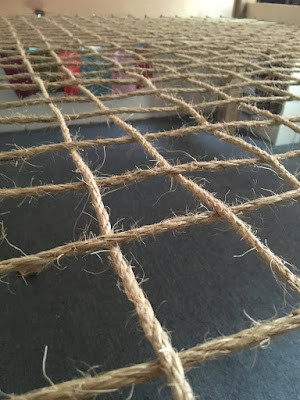For the last year or so, I've had a bed approximately four and a half feet in the air. That's what happens when you build a frame to fit a conventional mattress, forget that the corner posts will stick into the internal space of the frame by an inch at each corner, and end up having to sort of float the box spring on the end rail and the ropes tied around the headboard...
Planning. Even the children of engineers forget their essentials sometimes.
But all that is over now! Or it will be soon. I still have the conventional mattress, but I'm planning to replace it with a futon or two that will squish enough at the corners to suit the frame better (and to let me decrease the number of Things I Cannot Move Alone to...the couch).
 |
| Over under over under over under over under... |
Sneak preview. This bit actually comes later, but I love seeing woven structures done BIG.
 |
| Poor sagging ropes. |
So the original setup involved looping the ropes around the bed rails to sorta-kinda-not-really support the box spring, which ended up resting on the foot rail and on the ropes at the headboard, and really nowhere else. It was Not Ideal, but it served the purpose of getting the mattress high enough to allow storage underneath (and I was about four feet below the ceiling, which was fun).
 |
| High-tech method of determining how far my rope will go. |
Before drilling any holes in my nice bed rails, I needed to work out how many passes I could make with the rope, knowing that the more densely woven the rope layer is, the less the bed will tend to sag in the middle. What I didn't know was how long my rope was (oops), so I resorted to laying out the frame and looping the rope back and forth. Empirical data! And I wrote it down, so it's science.
 |
| Newly drilled lacing holes and project manager in back. |
Ultimately, I got 23 passes on the side rails, and 15 on the ends, which placed the holes about 3 inches apart. Satisfying, since that's about the placement I would've wanted had I been guessing anyway.
Not pictured: many hours of sanding the drilled holes to make them less hostile to ropes under strain. I cheated eventually and used a borrowed Dremel. Vastly improved speed and effectiveness—I was wearing through my sandpaper, my fingertips, and my patience at an alarming rate.
 |
| The extreme bowing on the side rails is totally intentional. Totally. |
We're not talking about how I laced half the bed before realizing I was going to come out on the wrong end to anchor the rope. It was a dark time.
Actually it was a bright and sweaty and cat fur in my eyes time. We're still not talking about it.
Bonus points to the lacing for at last being tight enough to brace the tenons in their mortises and minimize the squeakiness. It'll be grand to roll over and not sound like I'm surrounded by a chorus of the damned.
 |
| Pretty even weaving, despite half of it being done from underneath the frame. |
I actually came out
about 1.5 widths short on the horizontal rope, until I spent some quality time under the frame, hauling on ropes until they creaked to eke out enough to tie off the end. I'm sure after a week of sleeping on the bed, I'll have plenty to spare. The vertical rope, thankfully, was much closer—I only needed about eight inches after lacing it most of the way.
 |
| Back down to normal human bed height. |
Alas, I can no longer reach the ceiling light to turn it off when I'm going to bed. On the other hand, I don't need to find storage for all my blankets anymore...they're serving as the mattress until I save up enough for a futon mattress or two.







Comments
Post a Comment